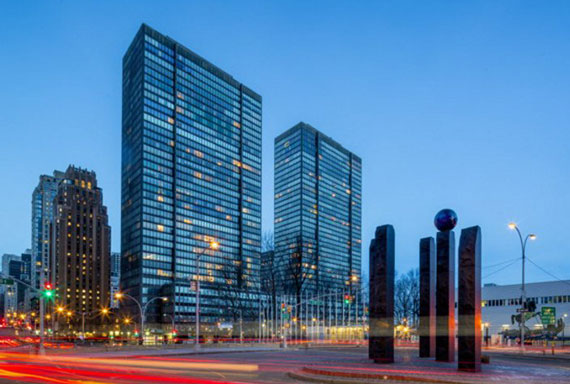Earlier this year, an office condo building in Chinatown sold out in just a few short months — all to Chinese businesses.
Farther uptown, across the street from the United Nations, the city’s largest recent office condo conversion brought 98 commercial units to the market late last year. Foreign buyers, such as diplomatic missions, are showing the most interest so far.
And in Eastern Queens, nearly all the recently built or under-construction office condos are located in Flushing, where buyers from the bustling Asian community dominate. Indeed, earlier this year, F&T Group, Rockefeller Group and AECOM Capital filed plans to develop 75 commercial condo units at its massive mixed-use project known as Flushing Commons. That is the largest outer borough commercial condo project in the works.
Much like they are in the residential condo market, foreign buyers are driving demand for office condos in New York City these days.
But commercial condos still represent just a tiny sliver of the new development taking place in the city. One of the best-known commercial-condo projects, the 89-unit International Gem Tower, which Extell Development opened in 2012, stands as an exception. Yet even after SL Green Realty purchased the upper floors, CoStar Group shows seven units with more than 100,000 square feet available.
Whether the commercial condo market will see a boost here might depend on how much demand from foreign buyers grows.
Purchases by foreign buyers are not seen solely as investments. They also simply illustrate cultural differences. Some business owners from outside the United States, for example, prefer to own, rather than rent, their office space. That is the case with investors from China and from a number of Latin American countries, sources say.
Charlotte Cheung, a principal with the brokerage Ariel Group Realty, said the Chinese are especially interested in office purchases. “They want to own their own units,” said Cheung, who represented Keystone Equities in selling its 28 commercial condo units at 202 Canal Street.
Meanwhile, Meadow Partners, the developer of 866 United Nations Plaza, is seeking to capitalize on the 471,000-square-foot building’s location just north of the world body headquarters.
“[Our investment play] keys around the foreign buyer more than anything else,” said Jeffrey Kaplan, managing partner at Meadow Partners.

Jeffrey Kaplan
Kaplan also pointed out that in some cases it makes more financial sense for foreigners to buy offices than to rent. Diplomats, for example, are exempt from paying New York City real estate taxes. If they lease office space, however, they end up paying an additional $10 or $15 per square foot per year on top of their rental rates.
In addition, owning an office space is more common in other parts of the world, so foreign businesses tend to be more comfortable with it.
“It is just a small niche in New York,” said Michael Rudder, a principal with Midtown-based Rudder Property Group, which focuses on commercial condo sales.
The fact that commercial office condos are a niche business in New York shows up in the numbers.
As of the middle of last month, developers only filed plans for 97 office units in Brooklyn, Queens and Manhattan. That compares with 151 for all of last year and 71 for all of 2013.
To put that in perspective, developers filed plans for more than 11,000 residential units since September 2012 for Manhattan alone, according to an analysis by The Real Deal of condo plans filed with the New York State Attorney General’s Office. The analysis only counted projects with five or more commercial units and where commercial units represented at least 20 percent of for-sale-units in the building. The analysis also excluded retail units, which have become increasingly popular investment vehicles, particularly in Manhattan.
So why the lack of interest in developing office condos in NYC?
Some say there is limited appeal because purchasing space comes with more restrictions. Kaplan, for one, said he did not expect to dive into more office condos.
“For us it was kind of a one-off. I won’t say never do it again, but it was very specific for this building,” Kaplan said.
That, however, could change if demand intensifies.
